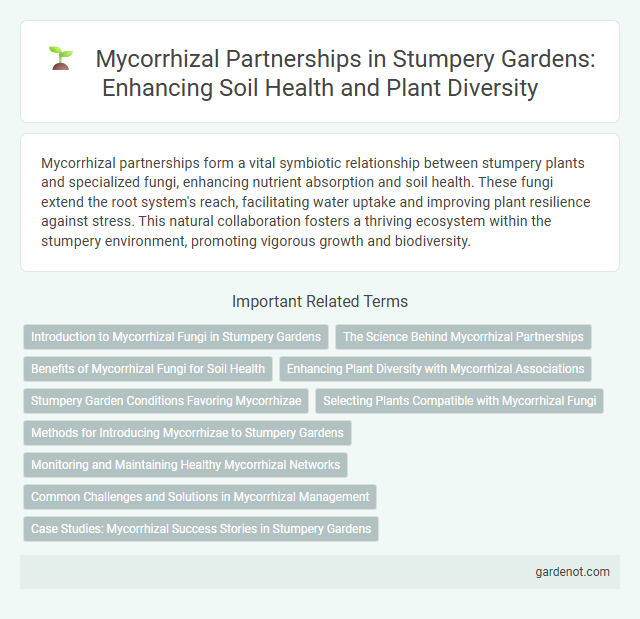Mycorrhizal partnerships form a vital symbiotic relationship between stumpery plants and specialized fungi, enhancing nutrient absorption and soil health. These fungi extend the root system's reach, facilitating water uptake and improving plant resilience against stress. This natural collaboration fosters a thriving ecosystem within the stumpery environment, promoting vigorous growth and biodiversity.
Introduction to Mycorrhizal Fungi in Stumpery Gardens
Mycorrhizal fungi form symbiotic relationships with tree roots in stumpery gardens, enhancing nutrient and water absorption essential for plant health. These fungi improve soil structure by connecting organic matter around decayed wood, promoting biodiversity and resilience. Leveraging mycorrhizal partnerships supports robust plant growth and sustainable ecosystems within the unique microhabitats of stumperies.
The Science Behind Mycorrhizal Partnerships
Mycorrhizal partnerships involve a symbiotic relationship between fungi and plant roots, where fungi enhance nutrient and water absorption while receiving carbohydrates produced by the plant through photosynthesis. Scientific studies reveal that these fungal networks increase plant resilience against pathogens, drought, and soil toxicity by improving soil structure and facilitating nutrient exchange. This mutualistic interaction is vital for ecosystem health, supporting plant biodiversity and productivity in stumpery environments.
Benefits of Mycorrhizal Fungi for Soil Health
Mycorrhizal fungi form symbiotic relationships with plant roots, enhancing nutrient and water uptake crucial for soil fertility. Their hyphal networks improve soil structure by increasing aggregation, which boosts aeration and moisture retention. These fungi also promote microbial diversity, driving nutrient cycling and suppressing soil-borne pathogens to maintain soil health.
Enhancing Plant Diversity with Mycorrhizal Associations
Mycorrhizal partnerships play a crucial role in enhancing plant diversity by facilitating nutrient exchange between fungi and plant roots, improving soil structure and fertility in stumpery environments. These symbiotic associations boost plant resilience to environmental stresses, promote seedling establishment, and increase species coexistence. By fostering a variety of mycorrhizal fungi species, stumperies support diverse plant communities, contributing to ecosystem stability and biodiversity conservation.
Stumpery Garden Conditions Favoring Mycorrhizae
Stumpery gardens create ideal conditions for mycorrhizal fungi by maintaining moist, shaded environments rich in decomposing wood and organic matter, which enhance fungal colonization. The decaying stumps provide a stable substrate that supports symbiotic mycorrhizal networks, improving nutrient and water uptake for surrounding plants. These conditions promote robust mycorrhizal partnerships, crucial for plant health and ecosystem resilience in stumpery settings.
Selecting Plants Compatible with Mycorrhizal Fungi
Selecting plants compatible with mycorrhizal fungi enhances nutrient uptake and soil health in a stumpery. Species such as oaks, maples, and wild garlic form strong mycorrhizal partnerships, promoting mutual growth and resilience. Incorporating these plants supports fungal networks that improve moisture retention and disease resistance in shaded, woody garden environments.
Methods for Introducing Mycorrhizae to Stumpery Gardens
Introducing mycorrhizae to stumpery gardens involves inoculating wood chips, logs, or soil with mycorrhizal fungi spores to establish symbiotic relationships with plant roots. Applying commercially available mycorrhizal inoculants during planting or as a soil drench promotes fungal colonization and enhances nutrient uptake. Integrating native woodland fungi by adding leaf litter or decayed wood sourced from local forests supports natural mycorrhizal diversity in stumpery ecosystems.
Monitoring and Maintaining Healthy Mycorrhizal Networks
Monitoring and maintaining healthy mycorrhizal networks in a stumpery involves regular soil testing to assess nutrient levels and microbial activity. Employing organic mulches and avoiding chemical fertilizers supports fungal symbiosis essential for root health and nutrient exchange. Consistent observation of plant vitality and soil moisture ensures optimal conditions for sustaining robust mycorrhizal partnerships.
Common Challenges and Solutions in Mycorrhizal Management
Common challenges in mycorrhizal management include soil disturbance, use of fungicides, and poor host plant selection, which can disrupt fungal networks and reduce symbiotic efficiency. Effective solutions involve minimizing tillage, applying targeted inoculants, and selecting compatible plant species to enhance fungal colonization and nutrient exchange. Monitoring soil health and maintaining organic matter further support robust mycorrhizal partnerships in stumpery ecosystems.
Case Studies: Mycorrhizal Success Stories in Stumpery Gardens
Mycorrhizal fungi establish symbiotic relationships with stumpery plants, enhancing nutrient uptake and soil structure, which supports healthier, more resilient growth in shaded garden environments. Case studies reveal species such as oak and beech thriving in stumperies, with ectomycorrhizal fungi like Amanita and Russula significantly improving root development and water absorption. These documented partnerships demonstrate increased biodiversity and ecosystem stability, making mycorrhizal management a critical factor in successful stumpery garden design.
Mycorrhizal partnership Infographic

 gardenot.com
gardenot.com